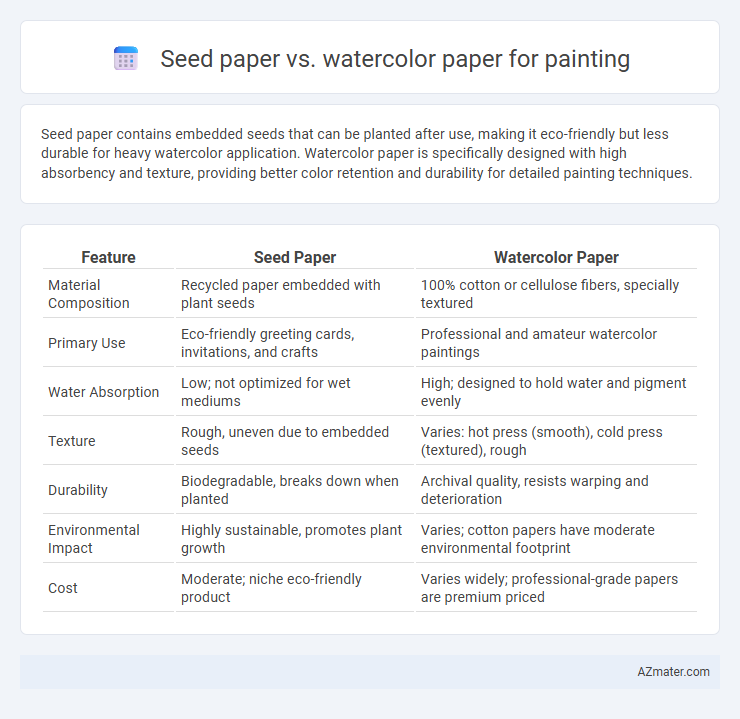Seed paper contains embedded seeds that can be planted after use, making it eco-friendly but less durable for heavy watercolor application. Watercolor paper is specifically designed with high absorbency and texture, providing better color retention and durability for detailed painting techniques.
Table of Comparison
| Feature | Seed Paper | Watercolor Paper |
|---|---|---|
| Material Composition | Recycled paper embedded with plant seeds | 100% cotton or cellulose fibers, specially textured |
| Primary Use | Eco-friendly greeting cards, invitations, and crafts | Professional and amateur watercolor paintings |
| Water Absorption | Low; not optimized for wet mediums | High; designed to hold water and pigment evenly |
| Texture | Rough, uneven due to embedded seeds | Varies: hot press (smooth), cold press (textured), rough |
| Durability | Biodegradable, breaks down when planted | Archival quality, resists warping and deterioration |
| Environmental Impact | Highly sustainable, promotes plant growth | Varies; cotton papers have moderate environmental footprint |
| Cost | Moderate; niche eco-friendly product | Varies widely; professional-grade papers are premium priced |
Introduction to Seed Paper and Watercolor Paper
Seed paper is an eco-friendly material embedded with plant seeds that can be planted after use, making it ideal for sustainable art projects and environmentally conscious artists. Watercolor paper, typically made from cotton or cellulose fibers, is specifically designed to absorb water and pigment evenly, providing a textured surface that enhances color blending and paint flow. Choosing between seed paper and watercolor paper depends on whether the priority is environmental impact or optimal performance for watercolor painting techniques.
Material Composition: What Sets Them Apart?
Seed paper is crafted from recycled paper pulp embedded with dormant seeds, allowing it to be planted and grow into flowers or herbs, emphasizing eco-friendly and biodegradable qualities. Watercolor paper is typically made from 100% cotton or cellulose fibers, designed to absorb water and pigments efficiently, providing a textured surface ideal for water-based painting techniques. The key distinction lies in seed paper's integration of organic seeds for sustainability versus watercolor paper's specialized fiber composition for artistic performance.
Texture and Surface Characteristics
Seed paper features a rough, fibrous texture infused with embedded seeds, offering a natural, tactile surface that absorbs paint unevenly and lends an organic effect to artwork. Watercolor paper is specifically designed with a smooth or slightly textured surface, typically made from cotton or cellulose, providing excellent water absorption and pigment retention for controlled wash techniques. The choice between seed paper and watercolor paper significantly impacts paint application, drying time, and detail precision due to their distinct surface properties.
Absorbency and Water Handling
Seed paper is highly absorbent, allowing it to soak up water quickly, which makes it ideal for light washes but can cause colors to bleed if over-saturated. Watercolor paper, especially those with cold press or hot press textures, is engineered to handle water more effectively, providing controlled absorption that enables layering and blending without warping. The superior water handling of watercolor paper ensures vibrant pigment retention and crisp edges, whereas seed paper's absorbency may result in softer, more diffused effects.
Paint Compatibility: Seed vs Watercolor Paper
Seed paper, made from recycled fibers embedded with seeds, is generally less compatible with heavy water-based paints due to its rough texture and absorbency, which can cause warping and bleeding. Watercolor paper, specifically designed for wet media, features a dense, textured surface that holds paint effectively, allowing for better color blending and minimal distortion. Artists seeking durability and vibrant results typically prefer watercolor paper over seed paper when working with watercolors or other liquid paints.
Durability and Longevity in Artworks
Seed paper is biodegradable and eco-friendly but tends to lack the durability required for long-lasting artworks, as it can deteriorate when exposed to moisture or heavy paint layers. Watercolor paper, typically made from 100% cotton or high-quality cellulose, offers superior longevity and resistance to warping, ensuring that paintings maintain their integrity over time. Artists seeking archival-quality results prioritize watercolor paper for its ability to withstand repeated washings and environmental stress without significant degradation.
Eco-Friendly Aspects: Sustainability Compared
Seed paper is an eco-friendly option made from recycled materials embedded with plant seeds, promoting sustainability by reducing waste and enabling users to grow plants after use. Watercolor paper, typically produced from virgin wood pulp or cotton fibers, has a higher environmental footprint due to resource-intensive manufacturing processes. Choosing seed paper supports circular economy practices and biodiversity, making it a more sustainable choice for environmentally conscious artists.
Cost and Accessibility for Artists
Seed paper offers an eco-friendly option with a generally higher cost due to its sustainable materials and limited production, making it less accessible for budget-conscious artists. Watercolor paper is widely available in various price ranges, providing artists with affordable choices suitable for different skill levels and styles. The accessibility and cost-effectiveness of watercolor paper make it the preferred choice for most painters seeking quality without a steep investment.
Creative Possibilities and Limitations
Seed paper offers unique ecological benefits and the creative possibility of growing plants from artwork, enhancing sustainability and interactivity in painting projects. Watercolor paper, with its textured surface and high absorbency, allows for precise color blending, layering, and detailed brushwork essential for traditional watercolor techniques. While seed paper may limit intricate detail due to its rough texture and potential moisture sensitivity, watercolor paper provides durability and control, making it ideal for artists prioritizing technique and long-lasting art.
Final Verdict: Choosing the Right Paper for Painting
Seed paper offers a unique eco-friendly option that integrates plant seeds for post-use planting, but its rough texture and absorbency can limit paint detail and vibrancy. Watercolor paper, specifically designed with high cotton content and suitable weight, ensures optimal paint absorption and color retention for both wet and dry techniques. For artists prioritizing durability and color precision, watercolor paper remains the ideal choice, whereas seed paper suits environmentally conscious projects with less emphasis on technical paint performance.

Infographic: Seed paper vs Watercolor paper for Painting
 azmater.com
azmater.com